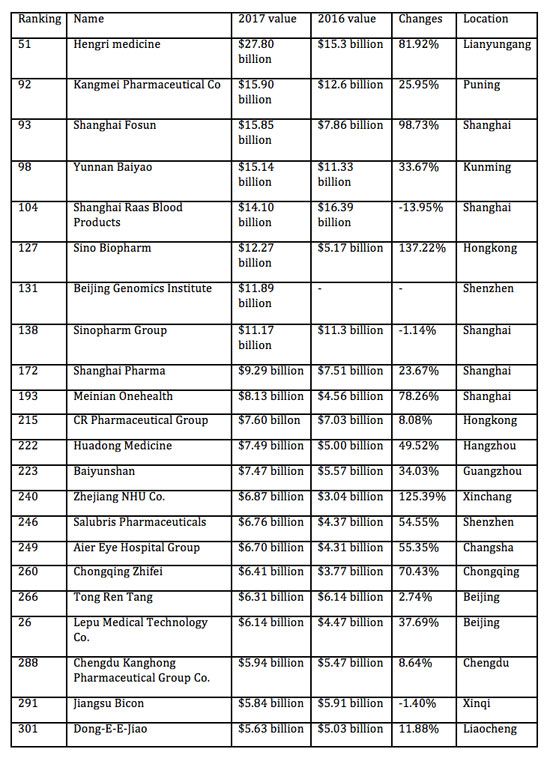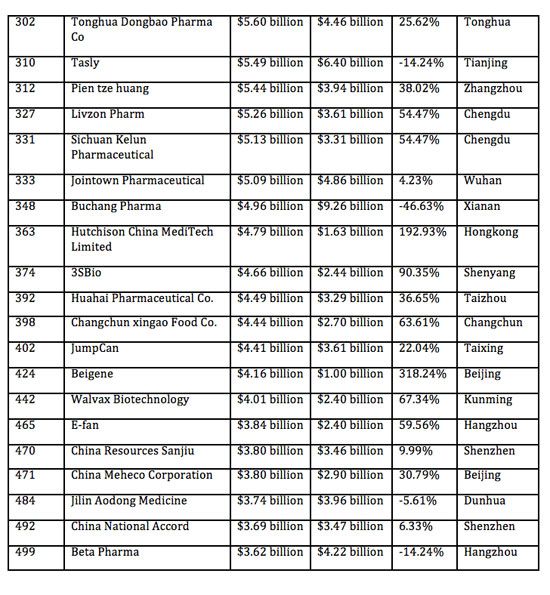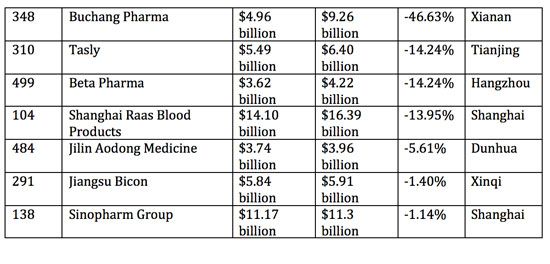The Chinese Pharmaceutical Industry: Winners and Losers 2017
Jin Zhang reviews the current fortunes of the Chinese pharmaceutical companies.
Jin Zhang reviews the current fortunes of the Chinese pharmaceutical companies.
Recently, East Money Information published their latest Chinese Top 500 company list of 2017. Among them, 42 pharmaceutical companies were listed and arranged into three distinctive tiers. So, who are the winners, and who lost out last year?
In terms of geography, Lianyungang stood out among the competition, beating Beijing, Shanghai, and Shenzhen to become the capital of the Chinese pharmaceutical industry. A large number of Chinese pharma giants have settled there, including Hengrui, Chiata Tianqing (~$13 billion) and Jiangsu Kanion (~$1.3 billion).
In 2017, Hengri maintained its lead position and closed the year with a total of $27 billion. Compared to 2016, its market value nearly doubled, increased up to 81.92% compared to the same period of last year. However, the fastest growing champion is Beigene, with a rise of 318.24% and a market value of $4.5 billion.


In 2017, the three tiers of Chinese pharmaceutical companies were formed.
Tier 1
The first tier consists of companies with a market value of more than $15 billion (¥$100 billion), and includes Hengri, Kangmei, Fosun, and Yunnan Baiyao.
In November 2017, Hengri became the first Chinese pharmaceutical company to exceed the $30 billion mark. This news sent shockwaves across the industry, but it came as no surprise. Combining innovation, globalization, and biosimilars development, Hengri has a clear leg-up on its competitors in terms of product line, R&D capabilities, and cash flow.
Following Hengri is Kangmei Pharmaceutical, which in May 2017 became the third A-share pharma company to exceed the $15 billion capital mark. As the leader in the traditional Chinese medicine sector, Kangmei has obtained a full control over both the upstream and downstream, from material to sale circulation to back-end hospitals and pharmacies.
On the heels of Kangmei, Yunnan Baiyao also joined the 15 billion-dollar club on June 13, 2017. This is shortly after its internal restructuring and reorganization, which concluded with the high-profile entry of Newhuadu Industrial Group and a massive capital injection from Jiangsu Yuyue.
The fourth is Shanghai Fosun, which has grown rapidly in the past year. At the end of 2016, its valuation was a mere $7.8 billion. However, by the end of 2017, this number doubled to $16 billion, following a series of strategic moves. Its deal with Gland, a generic drug maker in India, has finally begun to take off and made substantial progress. Additionally, it collaborated with Kite Pharma, the CAR-T industry leader, initiating Fosun Kite and officially kicking off the industrialization of CAR-T product in China. This investment-focused company is catching up fast in 2017.
On the flip side, Beijing Genomics had a valuation of $15.1 billion in November 2017, but within a few days entered a shakeout period. At the time of writing, its market value had dropped to $12 billion. The same is true for Shanghai Raas Blood Product. In the past few years, this company has grown rapidly through mergers and acquisitions. However, due to a controversial restructuring and reorganization, Shanghai Raas Blood Product’s market performance has slipped down significantly since the beginning of 2017, and eventually dropping out of the $15 billion-dollar club. Compared to 2016, its market value has fallen by 13.95%, ending 2017 with $14.1 billion.
Tier 2
The second tier consists of nine companies valued around $8 billion (¥50 billion) to $15 billion (¥100 billion), and includes evergreen brands like Baiyun Mountain, Sino Biopharma, and circulation giants such as Sino Pharm and Shanghai Pharma.
Worth noting is that these companies are the mainstay of the development of China's pharmaceutical industry today. The next $15 billion company are most likely to emerge from this group. As mentioned above, both Shanghai Raas and Beijing Genomics Institute have hit $15 billion valuations before.
Tier 3
The third tier consists of companies with a valuation between $4 billion (¥25 billion) and $8 billion (¥50 billion). Last year, Beta Pharma was ranked at 499 with a $4 billion valuation, marking the entry point to the whole industry top 500 list.
Geographical distribution of pharma companies
A large number of pharma companies in the top 500 are gathered around major metropolitan cities, with Beijing, Shanghai, and Guangdong leading the pack. Among them, Guangdong took the top spot, housing six companies, Beijing Genomics Institute, Livzon Pharma, Baiyun Mountain, Kangmei, China National Accord, and China Resources Sanjiu. Shanghai followed with five companies, Shanghai Fosun, Shanghai Pharma, Sinopharma Group, and Meinian Health. Beijing takes third place with Beigene, Lepu Medical Technology, China Meheco, and Tong Ren Tang.
The advantages of the major cities are obvious in terms of policy, talent, and transportation. However, it is not uncommon to find pharma giants in smaller scale cities. In the $15-billion group, none of the companies apart from Shanghai Fosun are located in major metropolitan cities. Hengri is based in Lianyungang, as are other famous biopharmas such as Hansoh and Chiatai Tianqing. Kangmei is headquartered in Puning, and Yunnan Baiyao is based in Kunming.
The highest market value increase
In 2017, Beigene, valued at 4.3 billion with an increase of 318.24% on the same period the previous year, took the crown of the highest market value increase.

Its soaring value followed an eventful 2017 for the company. In September, Beigene officially initiated its global strategic collaboration in immunoncology with pharma giant Celgene. The valuation of this program was estimated at $1.393 billion, setting a new record for the highest single-product technology and transfer deal in China. Beigene also established its first medicine production campus in Suzhou. Currently, two small molecule drugs are in development, BGB-3111 for lymphoma and BGB-290 for solid tumor. In 2017, Beigene officially become a full industry chain pharmaceutical company, completing its leap from R&D to production and marketing.
There is more to come in 2018. Viread is expected to be approved for Hepatitis B indications; the innovative TQB2450 injection (anti-PD-L1 monoclonal antibody) is slated to receive the go-ahead from CFDA to move into clinical trials; and Anlotinib, Lenalidomide, Bendamustine, and Gefitinib are on the track to score the CFDA approval in 2018 the earliest.
The worst market shrink: 46.63%
Although the majority of pharma companies in the top 500 increased their market value in 2017, seven companies took a hit. Among them, Buchang Pharma suffered the most, losing a total of 46.63%.

Buchang Pharma reached its peak December 30, 2016, with $13.6 per share amounting to a total market value of $9.3 billion. Just a year on, however, its share price dwindled to $7.2, and the company value had shrunk by more than $4.3 billion. The huge inherent risks associated with its product layout undoubtedly played an important role. Buchang Pharma has long relied on its three pillar products, Naoxintong Capsule, Wenxin Granule, and Danhong Injection, which have suffered in the current environment, where the monitoring of auxiliary drugs has been strengthened.
Another falling star is Beta Pharma, which was successfully listed in the A-share market last year. However, compared to a nearly $4.3 billion market value in 2016, Beta Pharma has dropped by 14.24% to $3.6 billion. The reason is that its product Gefitinib has dominated its portfolio and contributed almost 100% of its revenue. Overreliance on a single product is always risky behavior. Beta Pharma has since stepped up its efforts in R&D and M&A.
Outlook
As one of the US-listed Chinese pharmaceutical companies, the dramatic increase of Beigene’s market value proves that Chinese innovative pharma companies are gradually gaining attention and recognition in the global market. Following the footsteps of Beigene, Zai Lab has also successfully made its way into Nasdaq. What’s more, there are rumors that Hua Medicine and Innovent Bio are both planning their IPOs.
Ultimately, 2017 was a year of great achievement for the Chinese pharma ndustry. Its total market value increased 137.22% compared with the same period in 2016; pharmaceutical products in all sectors exceeded $150 million in sales; R&D investment fully blossomed; and in the third quarter of 2017, eight products received their production approvals, and 17 were greenlighted for clinical trials.
About the Author
Jin Zhang M.D., Ph.D is project and account manager at LakePharma, and editor at The Pharmaceutical Consultant.